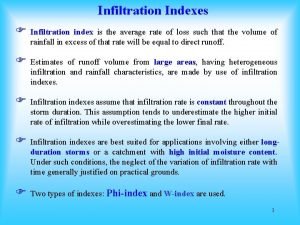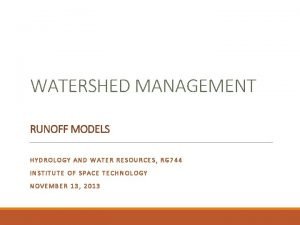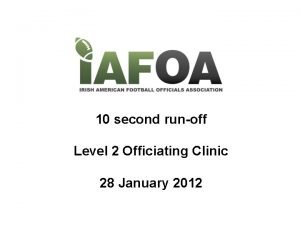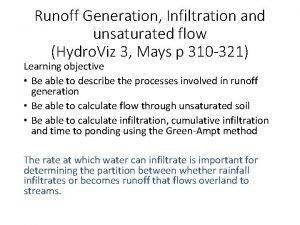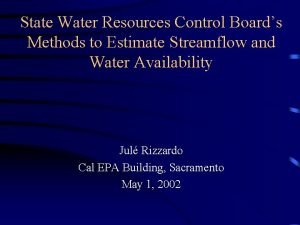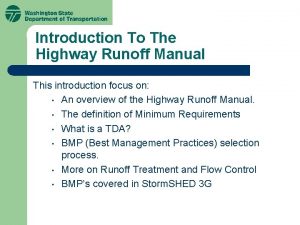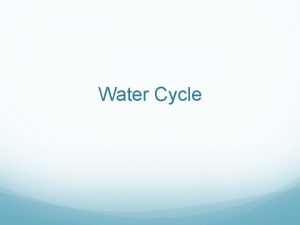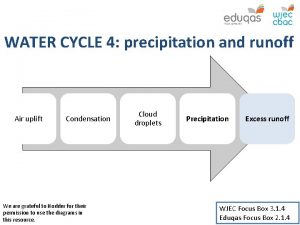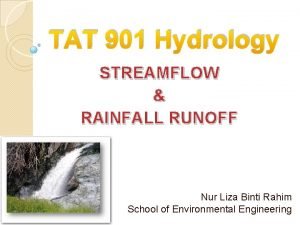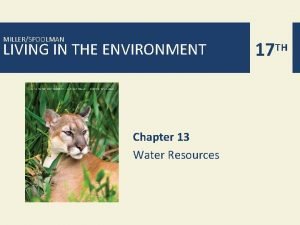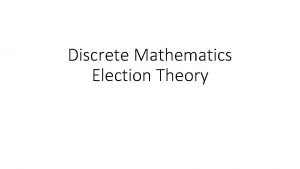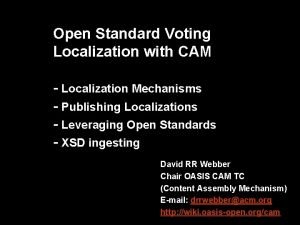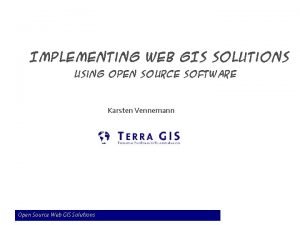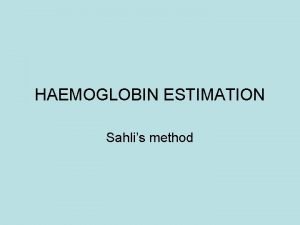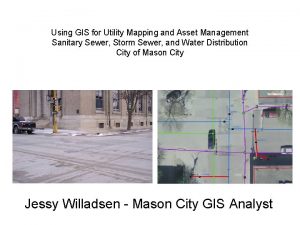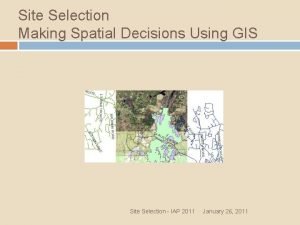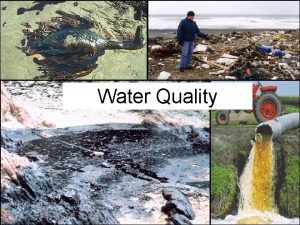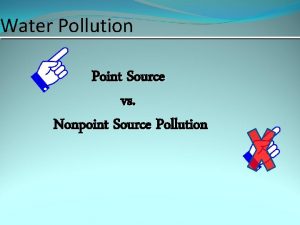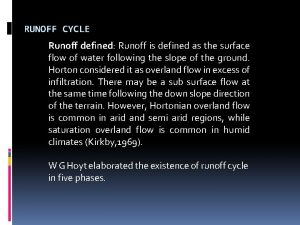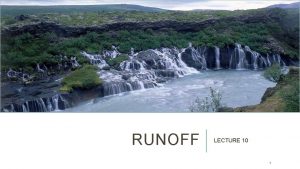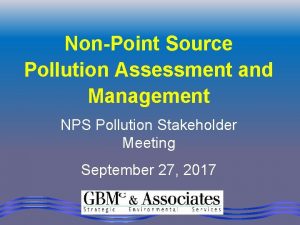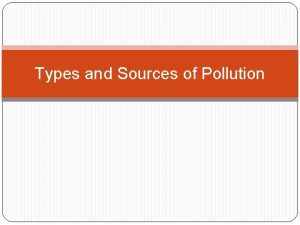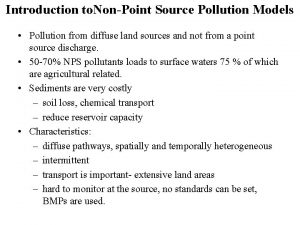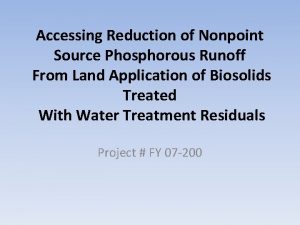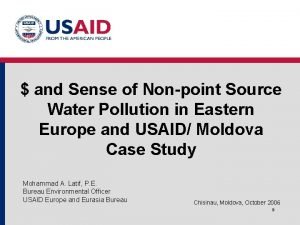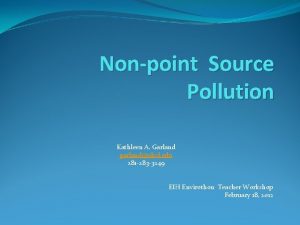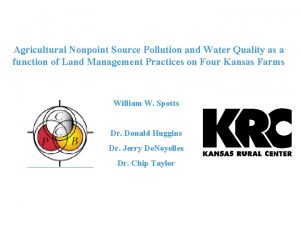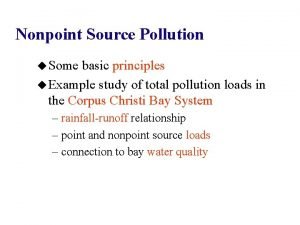Estimation of Runoff nonpoint source pollution using GIS


















- Slides: 18

Estimation of Runoff & nonpoint source pollution using GIS techniques By: Abedalrazq Khalil Utah State University 1

Estimation of Runoff and nonpoint source pollution using GIS techniques Introduction n. NPS pollutants are spread over broad areas encompassing hundreds, thousands or even millions of hectares of soil; millions of liters of water; and/or millions of cubic meters of air. Characteristically, NPS pollutants are ubiquitous, but are generally low in concentration; consequently, their impact upon human health, plants and animals is chronic in nature. n. The ability to model NPS pollutants provides an assessment tool for optimizing the utility of the environment by sustaining its use with minimal detrimental consequences. n. GIS serves as a means of storing, manipulating and displaying the tremendous volumes of spatial data associated with NPS pollutants. 2

Estimation of Runoff and nonpoint source pollution using GIS techniques Objective n. Both nitrogen (N) and phosphorus (P) have been identified as having water quality impacts in certain regions where concentrations become too high for the ecosystems in which they are found. n. The objectives of this study are to estimate the relationships between total phosphorus and total nitrogen concentrations and the relationships between these parameters and the land-use. The study area is the Snake River Basin in Idaho. 3

Estimation of Runoff and nonpoint source pollution using GIS techniques Methodology 4

Estimation of Runoff and nonpoint source pollution using GIS techniques Counties of Basin 5

Estimation of Runoff and nonpoint source pollution using GIS techniques Snake River 6

Estimation of Runoff and nonpoint source pollution using GIS techniques APPROACH n. Once the data layers were added to the GIS, some tabular manipulation was necessary in order to prepare it for use with the Arc. GIS, e. g. the landuse classification tables, hydrologic soil group data. Map Shows Landuse distribution. 7

Estimation of Runoff and nonpoint source pollution using GIS techniques curve number distribution. 8

Estimation of Runoff and nonpoint source pollution using GIS techniques Map shows runoff depth distribution in ‘cm’. 9

Estimation of Runoff and nonpoint source pollution using GIS techniques Runoff volume grids were calculated using the runoff depth grids, and land use/soil index , and the curve number using this equation: The estimated average annual runoff depth and volumes are greatest in the cities. This is because of the impervious nature of an urban landscape due to concrete, pavement, and density of buildings. The areas with lowest runoff depth are located near the rivers and streams. These are the lowest elevation areas and are also the outlets of the watershed. The runoff depth in the agricultural areas is medium to low. Map shows Runoff Volume in m 3. 10

Estimation of Runoff and nonpoint source pollution using GIS techniques The expected mean concentration (EMC) of nitrogen and phosphorus which depend on the each land use are entered to tables. 11

Estimation of Runoff and nonpoint source pollution using GIS techniques Finally, NPS pollutant loading grids were generated via the runoff volume grids. Union the Landuse them and the Runoff Volume theme; multiply Runoff volume times the expected values of P and N for each land use. Nitrogen Load (Kg/ha/year) 12

Estimation of Runoff and nonpoint source pollution using GIS techniques Phosphorus Load (Kg. /ha/Year) It is shown clearly on these maps that lead pollution potential is greater in the city than in the agricultural areas. The areas of greatest risk are the commercial, industrial, and the high-density residential areas. Phosphorus is often more problematic in an urban setting. • The final step was preparation of the data for presentation. 13

Snake River Counties of Basin Site Selection Shape No Precipitation Map Total Volume of Runoff(m ) 3 Phosphorus Load Delineated Watershed Land Use Nitrogen Load (Kg/ha/year) (Kg. /ha/Year) Projection: Estimation of Runoff and nonpoint source pollutants loads North American Datum of 1927 Clarke 1866 Data Sources: The estimated average annual runoff depth and volumes are greatest in the cities. This is because of the impervious nature of an urban landscape due to concrete, pavement, and density of buildings. The areas with lowest runoff depth are located near the rivers and streams. These are the lowest elevation areas and are also the outlets of the watershed. The runoff depth in the agricultural areas is medium to low. Idaho Department of Water Resources, Version of June 8, 1994 URL: http: //www. idwr. state. id. us/gisdata/ Date: November 10, 2002 Cartographer: Abedalrazq F. Khalil 14

15

Estimation of Runoff and nonpoint source pollution using GIS techniques Conclusions 16

Cont. Conclusions §The study confirmed that the presence of phosphorus in a stream necessitates the presence of nitrate and vise versa. §The results of the study will be useful in developing and calculating the water quality indexes, which require information about several water quality parameters that may not be available for many watersheds. §These types of results can be very useful to raise awareness of the potential long-term effects of land use changes within a watershed. 17

Estimation of Runoff and nonpoint source pollution using GIS techniques RECOMMENDATIONS THANKS 18
 Antecedent moisture condition
Antecedent moisture condition Direct runoff hydrograph formula
Direct runoff hydrograph formula Nfl 10 second runoff rule
Nfl 10 second runoff rule Runoff generation
Runoff generation Runoff coefficient
Runoff coefficient Highway runoff manual
Highway runoff manual Khosla formula for runoff
Khosla formula for runoff Blue water cycle
Blue water cycle Runoff
Runoff What is a runoff sentence
What is a runoff sentence Factors affecting runoff
Factors affecting runoff How to prevent soil runoff on a slope
How to prevent soil runoff on a slope Sequential runoff example
Sequential runoff example Instant runoff voting excel template
Instant runoff voting excel template Ceserver
Ceserver Estimation of haemoglobin using sahli's haemoglobinometer
Estimation of haemoglobin using sahli's haemoglobinometer Utility mapping using gis
Utility mapping using gis Making spatial decisions using gis
Making spatial decisions using gis Point source pollution examples
Point source pollution examples
